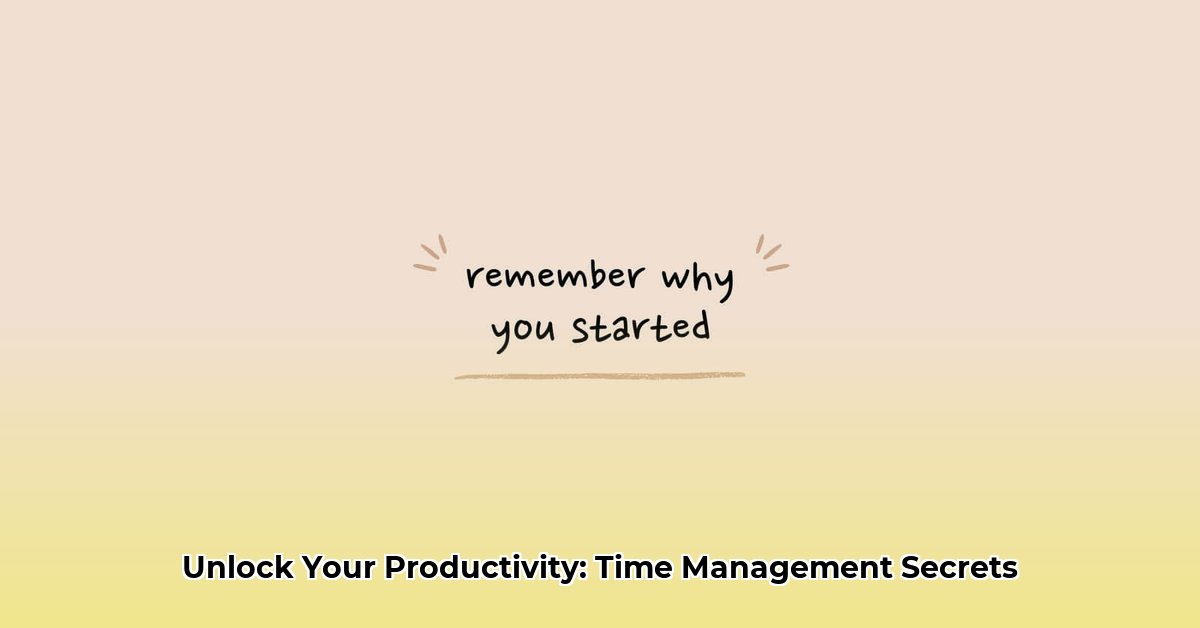Do you feel like there’s never enough time? Are you constantly juggling tasks, deadlines, and personal commitments, leaving you feeling overwhelmed and stressed? You’re not alone. Many people struggle with managing their time effectively, which can negatively impact their productivity, well-being, and overall success. But the good news is, time management is a skill that can be learned and improved with the right strategies and techniques. For more foundational principles, check out this helpful guide on time management principles.
This comprehensive guide will equip you with the knowledge and tools you need to take control of your time, boost your productivity, and achieve your goals. We’ll delve into the core principles of time management, explore various proven techniques, address common challenges, and provide actionable tips for creating a personalized system that works for you. Get ready to transform your relationship with time and unlock your full potential!
The Power of Time Management: Why It Matters
Time management is much more than just scheduling tasks and meeting deadlines. It’s about strategically planning and utilizing your time to maximize your productivity, minimize stress, and achieve a greater sense of control over your life. Effective time management allows you to prioritize what’s most important, focus your energy on high-impact activities, and create a sustainable work-life balance.
Think of time management as the conductor of an orchestra. Each instrument (task, commitment, goal) has its part to play, and the conductor ensures that everything comes together harmoniously to create a beautiful symphony. Without effective guidance, the orchestra would be chaotic and disorganized, resulting in a disjointed and unpleasant sound. Similarly, without time management, your life can become chaotic and overwhelming, leading to missed opportunities, increased stress, and decreased overall satisfaction.
Here are some key benefits of mastering time management:
- Increased Productivity: By prioritizing tasks and allocating time efficiently, you can accomplish more in less time.
- Reduced Stress: Effective time management helps you stay organized, avoid last-minute rushes, and feel more in control of your workload.
- Improved Focus: By eliminating distractions and concentrating on one task at a time, you can enhance your focus and improve the quality of your work.
- Better Decision-Making: When you’re not feeling rushed or overwhelmed, you can make clearer, more informed decisions.
- Enhanced Goal Achievement: Time management helps you break down large goals into smaller, manageable steps and allocate time for each step, increasing your chances of success.
- Work-Life Balance: By effectively managing your time, you can create space for personal activities, hobbies, and relationships, leading to a more balanced and fulfilling life.
- Increased Opportunities: Time management frees up time to pursue new interests, attend workshops, and network with others, opening doors to new opportunities for personal and professional growth.
Proven Time Management Techniques: Finding What Works For You
There’s no one-size-fits-all solution when it comes to time management. The most effective approach is to experiment with different techniques and strategies to find what resonates with your individual needs, preferences, and work style. Here are some popular and proven time management techniques to get you started:
- The Pomodoro Technique: This technique involves working in focused bursts of 25 minutes, followed by a short 5-minute break. After every four “pomodoros,” take a longer break of 15-20 minutes. This method helps maintain focus and prevent burnout by providing regular mental breaks.
- Time Blocking: Time blocking involves dividing your day into specific blocks of time, each dedicated to a particular task or activity. This creates a structured schedule and ensures that you allocate sufficient time for your priorities.
- The Eisenhower Matrix (Urgent/Important Matrix): This powerful prioritization tool helps you categorize tasks based on their urgency and importance. Tasks are divided into four quadrants:
- Urgent and Important: These tasks require immediate attention and should be done right away (e.g., crises, deadlines).
- Important but Not Urgent: These tasks are crucial for long-term success and should be scheduled for later (e.g., planning, relationship building).
- Urgent but Not Important: These tasks can be delegated to others (e.g., interruptions, some meetings).
- Neither Urgent nor Important: These tasks should be eliminated or minimized (e.g., time-wasting activities).
- Getting Things Done (GTD): This comprehensive system, developed by David Allen, focuses on capturing all your tasks and ideas, organizing them into actionable steps, and prioritizing them based on context and energy levels.
- The Two-Minute Rule: If a task takes less than two minutes to complete, do it immediately. This prevents small tasks from piling up and becoming overwhelming.
- Eat the Frog: Tackle your most challenging or unpleasant task first thing in the morning. This gets it out of the way and allows you to approach the rest of your day with a sense of accomplishment.
- SMART Goals: Set Specific, Measurable, Achievable, Relevant, and Time-bound goals to provide clarity and direction for your time management efforts.
Pros and Cons of Popular Time Management Strategies:
| Technique | Advantages | Disadvantages |
|---|---|---|
| Pomodoro Technique | Enhances focus, minimizes burnout, easy to implement, promotes consistent progress | Requires self-discipline, may not suit all tasks, inflexible break times can be disruptive |
| Time Blocking | Provides structure, reduces mental burden, clearly visualizes progress, promotes focused work | Requires careful planning, can be inflexible, unexpected events can disrupt schedule, may feel restrictive |
| Eisenhower Matrix | Effective prioritization, reduces overwhelm, enhances task understanding, clarifies focus | Needs honest self-evaluation, subjectivity can cause errors, potential for urgency bias, can be time-consuming |
| Getting Things Done | Comprehensive system, promotes clarity and control, adaptable to individual needs, reduces stress | Can be complex to set up, requires ongoing maintenance, may feel overwhelming for some |
Creating Your Personalized Time Management System
While the above techniques offer a solid foundation, the key to long-term success lies in creating a personalized system that aligns with your unique needs, preferences, and circumstances. Here’s a step-by-step guide to help you design your own time management system:
- Assess Your Current Time Management Habits: Start by tracking how you spend your time for a week or two. Identify your biggest time-wasters, peak productivity periods, and areas where you struggle to stay focused.
- Define Your Goals and Priorities: What do you want to achieve in your personal and professional life? What are your most important values and priorities? Clarifying your goals will help you determine which tasks and activities deserve your time and attention.
- Choose Your Techniques: Based on your assessment and goals, select a few time management techniques that you think will work best for you. Don’t be afraid to experiment and try different combinations.
- Create a Schedule or Plan: Use a calendar, planner, or digital app to create a visual representation of your schedule. Block out time for your most important tasks, meetings, appointments, and personal activities. Be realistic about how much time each task will take and build in buffer time for unexpected interruptions.
- Implement and Evaluate: Put your system into practice and track your progress. Regularly evaluate what’s working and what’s not. Make adjustments as needed to optimize your system and ensure that it continues to meet your needs.
- Be Flexible and Adaptable: Life is unpredictable, and unexpected events will inevitably disrupt your schedule. Be prepared to adapt your plan as needed and don’t get discouraged by setbacks.
- Prioritize Self-Care: Remember that time management is not just about maximizing productivity; it’s also about creating a sustainable lifestyle that supports your well-being. Make sure to schedule time for activities that help you relax, recharge, and maintain your physical and mental health.
Technology as a Tool: Leveraging Apps and Resources Wisely
Technology can be a powerful ally in your time management efforts, but it’s important to use it mindfully and avoid becoming overwhelmed by notifications and distractions. Here are some popular apps and resources that can help you stay organized, focused, and productive:
- Calendar Apps: Google Calendar, Outlook Calendar, Apple Calendar
- Task Management Apps: Todoist, Trello, Asana, Microsoft To Do
- Note-Taking Apps: Evernote, OneNote, Google Keep
- Focus Apps: Freedom, Forest, Serene
- Time Tracking Apps: Toggl Track, RescueTime
When choosing apps, consider factors such as ease of use, features, integration with other tools, and cost. Start with a few essential apps and gradually add more as needed. Remember to set boundaries around your technology use and schedule regular periods of disconnection to avoid digital burnout.
Overcoming Common Time Management Challenges
Even with the best strategies and tools, you’ll inevitably encounter challenges along the way. Here are some common time management obstacles and how to overcome them:
- Procrastination: Break down large tasks into smaller, more manageable steps. Set realistic deadlines and reward yourself for completing tasks.
- Perfectionism: Aim for “good enough” instead of striving for perfection in every task. Recognize that mistakes are a part of the learning process.
- Distractions: Identify your biggest distractions and take steps to minimize them. Turn off notifications, create a dedicated workspace, and let others know when you need uninterrupted time.
- Interruptions: Set boundaries and let others know when you’re unavailable. Schedule regular breaks to check email and respond to messages.
- Overcommitment: Learn to say “no” to requests that overload your schedule. Prioritize your commitments and focus on what’s most important.
- Lack of Motivation: Connect your tasks to your overall goals and values. Reward yourself for completing tasks and celebrate your progress.
The Journey to Time Mastery: Embrace Continuous Improvement
Effective time management is not a destination but a journey of continuous improvement. Be patient with yourself, experiment with different techniques, and don’t be afraid to adjust your system as needed. Celebrate your successes, learn from your setbacks, and embrace the process of becoming a more efficient, productive, and balanced individual.
By mastering time management, you’ll not only achieve more in your personal and professional life but also create more space for what truly matters: your relationships, your passions, and your overall well-being. So, take the first step today and embark on your journey to time mastery!
- Unlock Work-Life Harmony:Your Guide to Integration - November 27, 2025
- Find Your Work-Life Balance Quotes: Achieve Harmony Now - November 25, 2025
- Unlock Physician Assistant Work Life Balance: Your Guide to Fulfillment - November 23, 2025
















